The Arctic Liquid Freezer III 280 A-RGB White AIO Review: Refined Design Brings Stand-Out Cooler
by E. Fylladitakis on March 13, 2024 9:00 AM ESTTesting Results, Maximum Fan Speed
Our maximum speed testing is performed with both the fans and the pump of the kit powered via a 12V DC source. This input voltage should have the pump and fans matching the speed ratings of the manufacturer. According to ARCTIC’s P14 PST fan specifications, the fans should have a maximum rotational speed of 1900 RPM. Our tachometer indicated that the fans were rotating at an average speed of exactly 1880 RPM, very close to their rated specifications.
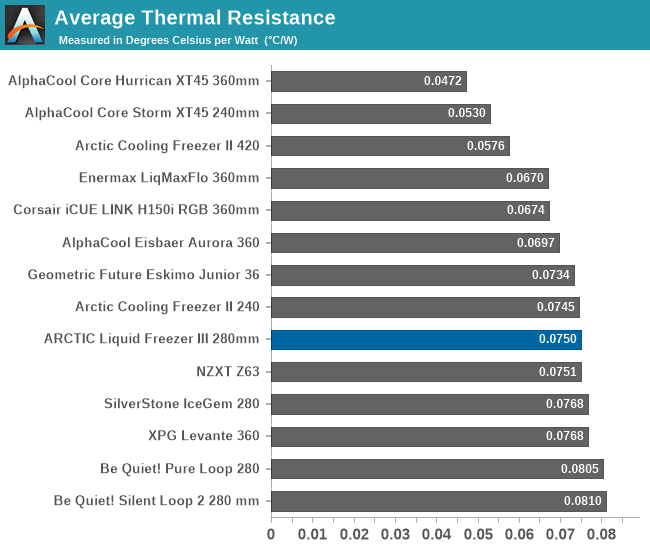
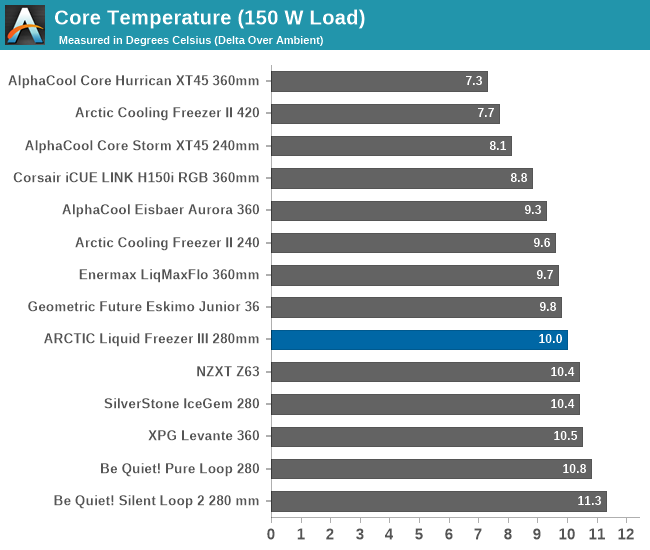
| Core Temperature, Constant Thermal Load (Max Fan Speed) |
The ARCTIC Liquid Freezer III 280 mm has an average thermal resistance of 0.075 °C/W with its fans running at maximum speed, outperforming most similarly sized offerings in terms of raw thermal performance, especially older products. Although its raw thermal performance seems to be barely matching that of the older and smaller Liquid Freezer II 240 mm model, the Liquid Freezer III is significantly quieter under the same operating conditions.
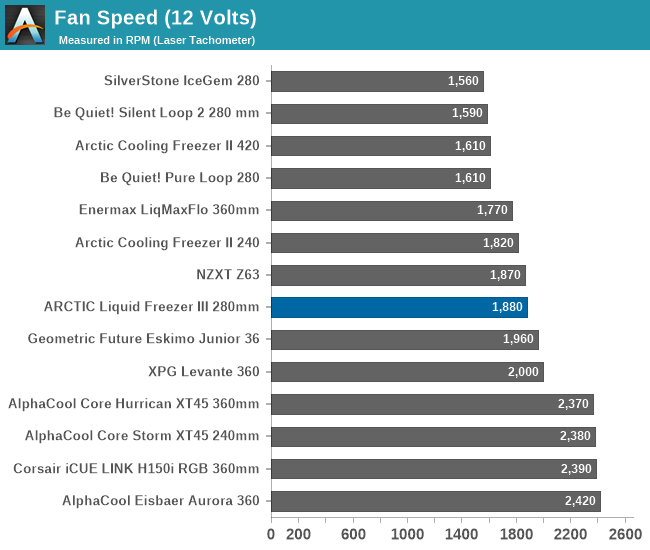
The Sound Pressure Level (SPL) of the ARCTIC Liquid Freezer III 280 mm with all of its components running at maximum speed is 40.4 dB(A), which is a good figure, yet it could have been better. Having a dedicated VRM fan plays a role here, as it contributes to the overall SPL level of the entire setup.
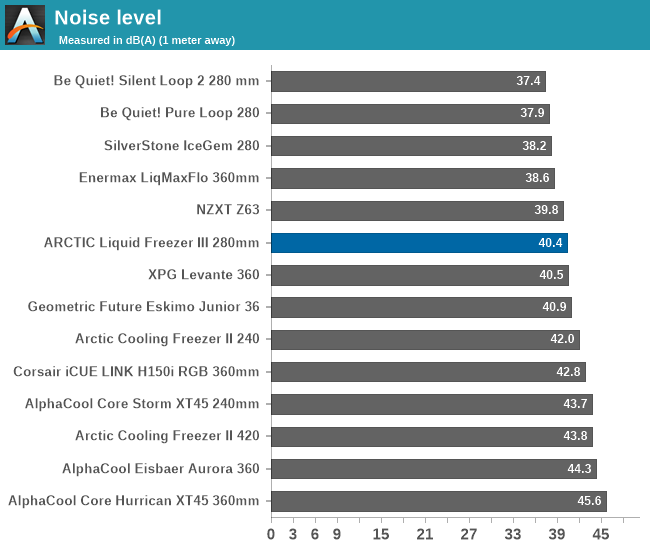
Testing Results, Low Fan Speed
Using a PWM voltage regulator, we reduced the speed of the fans manually down to half their rated speed. At this setting, the 140 mm fans of the Liquid Freezer III 280 mm rotate at 950 RPM. Note that this also affects the speed of the pump and VRM fan as well.
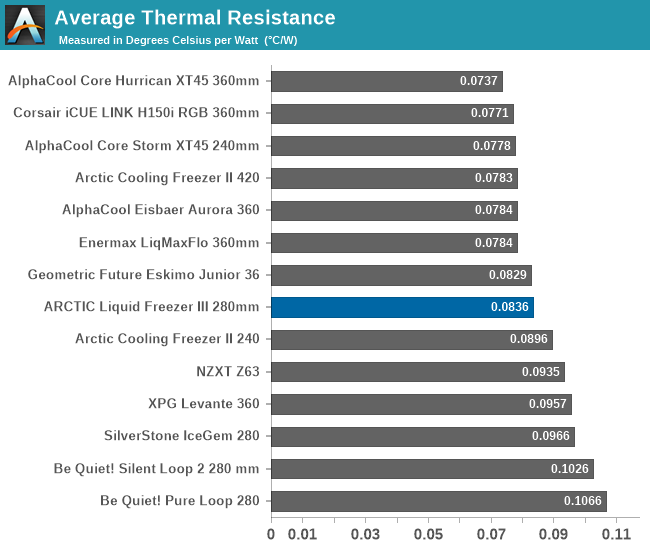
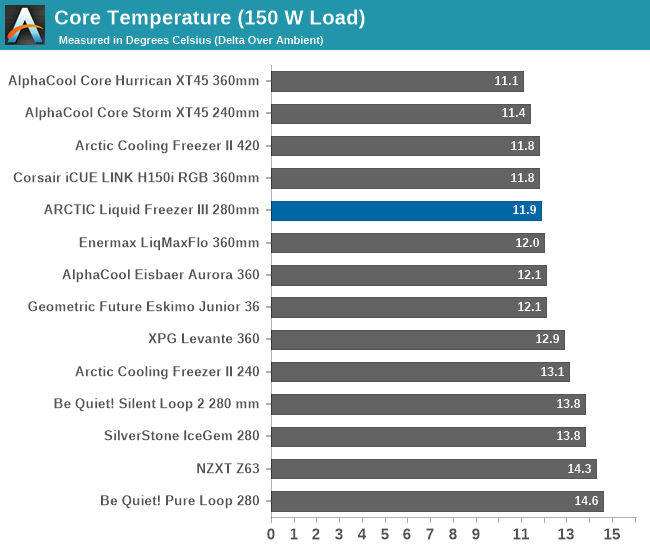
| Core Temperature, Constant Thermal Load (Low Fan Speed) |
The high mass of the radiator gives the Liquid Freezer III 280 mm a strong advantage here, with its average thermal resistance rising to just 0.0836 °C/W. Its thermal resistance is fairly stable regardless of the load, suggesting a good thermal transfer design, despite its small contact plate. This places ARCTIC’s latest 280 mm cooler in direct competition with 360 mm AIO coolers and even close to the 420 mm version of the Liquid Freezer II, which used to perform a little better but at a much higher noise level.
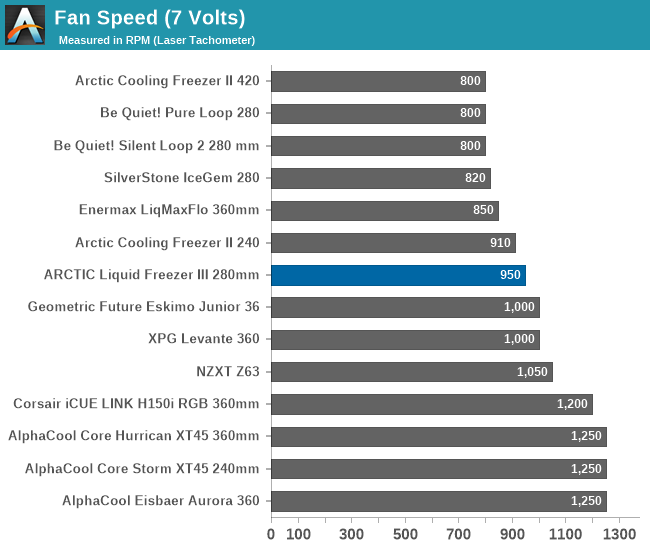
With the fans at half speed, the noise levels drop to 33.1 dB(A), a figure that may not be as low as that of other similarly sized products that were engineered toward quiet operation, yet it is perfectly comfortable for even the most sensitive of ears. Under typical conditions, it should be nearly impossible for a user to discern the sound coming from the Liquid Freezer III 280 mm.
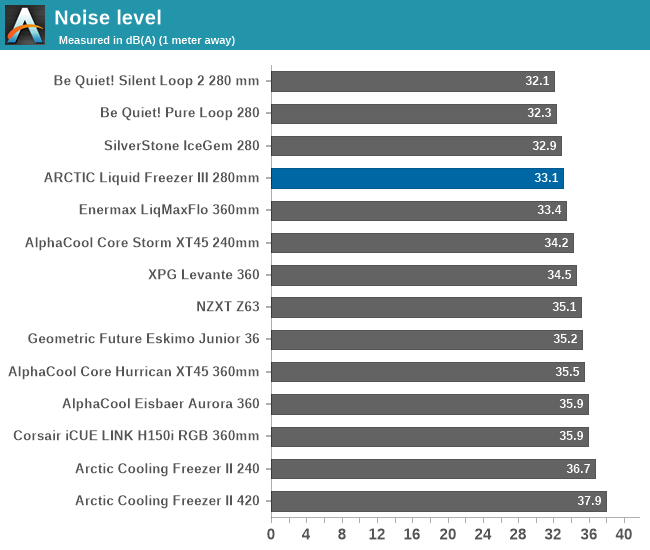
Thermal Resistance VS Sound Pressure Level
During our thermal resistance vs. sound pressure level test, we maintain a steady 100W thermal load and assess the overall performance of the coolers by taking multiple temperature and sound pressure level readings within the operating range of the stock cooling fans. The result is a graph that depicts the absolute thermal resistance of the cooler in comparison to the noise generated. For both the sound pressure level and absolute thermal resistance readings, lower figures are better.
This chart is highly revealing regarding the overall performance of the Liquid Freezer III 280 mm, with the cooler having one of the smallest inclinations we have ever seen. What that translates to is that the thermal performance of the Liquid Freezer III 280 mm is only slightly affected by the speed of the cooling fans. At first sight, this would suggest that the size of the heat exchange area is disproportionally low compared to the cooler’s capability to transfer thermal energy from the CPU to the radiator – however, manipulating the speed of the fans also affects the speed of the pump, which should play a significant role to the rate of transfer between the block and the radiator. From the above, we can only surmise that the contact plate is what limits the overall performance of the Liquid Freezer III 280 mm, which does perform very well under typical conditions but has little-to-no room for further improvement.











8 Comments
View All Comments
Maksdampf - Wednesday, March 13, 2024 - link
Coldplate size (thats the technical term, not „contact plate“) being too little is not a reason for the bad performance. What matters is not the size of the copper chunk, but its active area. The active finned area must be the same size or larger then the DIE underneath the IHS. But the fin area and water channels are similarly sized as the competitors.More likely your decades old testing Station has a far thicker baseplate or DIE size compared to a real CPU, so the measurements are not realistic. Time to make a new DIE simulator.
But i assume there is something else wrong too.
The baseplate in the Liquid freezer II is the same, but it is performing better, so this test result must be worse due to a bent IHS or a fault with the mounting hardware.
Since every other media outlet so far has seen improvements compared to the LF II series, i would not have published these results without further research into the issue. Reply
E.Fyll - Wednesday, March 13, 2024 - link
The descriptive term "CPU contact plate" is very frequently used by professionals and amateurs alike. True, the correct technical term for liquid coolers is "cold plate" but I personally choose to use casual language and descriptive terms when appropriate, as I don't expect every single reader to be familiar with the technical terminology.The mass and size of the cold plate do matter in several ways. The "active" area does matter but it is not the only thing that does. It actually doesn't even matter the most - the shape is what matters the most as it affects both the movement of the liquid (boundary layer fluid mechanics) and the transfer of energy between the mediums. If the liquid contact area of the cold plate was all that mattered for performance, it would be shaped in the form of a small rectangular finned corridor for the fluid to flow through, similar to how finned radiators are shaped, multiplying the liquid contact area compared to current designs. Still, that design doesn't work quite well despite the much greater liquid contact area, for a number of reasons.
The testing station does not fully replicate a specific CPU's die, which is a very high thermal load concentrated in a very small area, but spreads the thermal energy almost evenly across the entire contact plate, replicating an ideal 40x40 IHS. It is perfectly valid for measuring the thermal resistance of coolers without relying on case-specific parameters. If I were to make the faux die that is the exact shape and die of any processor, the test results would be completely incomparable not only between generations of processors but between different sockets as well.
I have learned not to take too much heed to other people's test results as I frequently cannot match mine with those no matter how hard I try. I did double-check this review's test results because I found them very strange myself, which is why the review was late (again). Yes, the cold plate may be similar/identical but not the entirety of the cooler is. There are myriads of factors that affect performance, down to the very paint on the radiator.
For those that are a bit distrustful, or even cynical, one should also consider that I could very well be "cooking" the results to whatever I want and avoid confrontations such as this one but, as you can tell, I choose to go with the actual readings and deal with the fallout instead. Reply
Maksdampf - Thursday, March 14, 2024 - link
Yeah, i get it, turbulent flow for boundary layer separation is important too. I wasn't saying that the internals don't matter, and you weren't saying anything about internals in your article either. I was just saying that you can't judge a book by its cover or a waterblock by its coldplate size.The mass of the coldplate is really not that important. A heavier and thus thicker coldplate performs worse in most cases because even pure copper would be an insulator between the flowing water and CPU, adding thermal resistance. Also when talking about thermal mass, you mean thermal capacity most likely. Thermal capacity of copper is almost negligible compared to water. So if you wan't mass simply for thermal inertia in a waterblock it is much better to have water there instead of copper soaking up the heat. So less copper performs better in many cases.
I understand that the somewhat bad results of this CLLC are most likely down to the test platform specifics and not your thorough measuring process. But still, how valuable are they then?
If you knew this and even doublechecked the results, how could you not write something about this discrepancy and its most likely cause in your review? Instead you make something up with coldplate size, which doesn't matter on a real CPU and only the very thermodynamics literate and curious people can summize that the Testing setup may be the reason here why this CLC performs so bad an others so well.
I get it that you don't wan't to throw away 20 years of comparability between coolers by still using the same platform. But then i don't undertsnd why you are not using any of the Data. Why is the graph not a javascript generated one where i can select my comparision with a drop down menu?
I also don't get these 12V and 7V measurements instead of noise normalized bar charts which are much easier to undertand for a consumer. 20 years ago people limited their fanspeed by connecting it to the +12V and +5V DC from the PSU directly, but nowadays in the Age of PWM nobody cares.
All other outlets have switched to noise normalized values, which you could be doing too, since you have the data vor a curve. But you chose not to.
I myself was developing waterblocks 20 years ago and hat a very similar test platform using a microcontroller and a fet heater. I used a Athlon64 IHS with a small 15x15mm copper block soldered onto the middle where the fet was screwed onto and a probe was drilled inserted in a small drilled hole on the side to measure exactly central to the die.
Even this had slightly different results to real CPUs. I have stopped doing that back then since i could not be true to my aspirations.
These Tests are not good for anybody looking for an AIO or Aircooler today. Things like offset mounting for AMD or contact frame play a huge role and you just ignored that. Reply
osv - Friday, March 15, 2024 - link
re: your misplaced claims, for instance, "These Tests are not good for anybody looking for an AIO or Aircooler today"what i see is that you didn't actually read the review, and therefore your comments are not helpful, and your criticisms are not valid.
for example, your claim: "nowadays in the Age of PWM nobody cares"... umm no, as the article repeatedly pointed out, the speeds of the pump vs. cooler fans vs. vrm fans can't be controlled individually, which is a drawback for tuners who want those options, and had it years ago... i appreciate that the author made that point wrt price, while you apparently don't understand what matters to people reading these articles.
i appreciate that the data posted backs up his conclusion that "This places ARCTIC’s latest 280 mm cooler in direct competition with 360 mm AIO coolers and even close to the 420 mm version of the Liquid Freezer II, which used to perform a little better but at a much higher noise level."
you claimed: "the Testing setup may be the reason here why this CLC performs so bad"... except that it didn't test badly, it was quieter than the competition, which is a high priority for many readers, and the author got that; you didn't. Reply
Lolshutupbro - Tuesday, March 19, 2024 - link
The pump speed, fan and vrm fan can be controlled individually, there is a cable included…. Replym3city - Thursday, March 14, 2024 - link
I asked this before, but never got a response, and asking google does not really give an answer as well: why is there no comparison to an air cooler? A stock one would be the best, but any would be great. I still don't know what will I gain in terms of loudness, temps, OC/boost headroom? ReplyPeachNCream - Thursday, March 14, 2024 - link
Here ya gohttps://gamersnexus.net/megacharts/cpu-coolers Reply
m3city - Friday, March 15, 2024 - link
Thank you very much! That is exactly what I was looking for. Reply